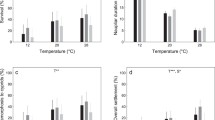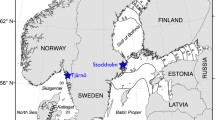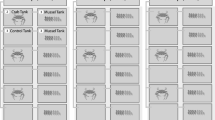Abstract
When juvenile mortality or juvenile growth is impacted by temperature and salinity, these factors have a substantial effect on recruitment success and population dynamics in benthic ecosystems. Using freshly settled cyprids of Amphibalanus improvisus, we investigated the combined effects of temperature (12, 20 and 28 °C) and salinity (5, 15 and 30 psu) on early juvenile stage performance. Mortality as well as size (basal diameter, dry weight, and ash-free dry weight) was monitored for a period of 40 days. Mortality was high (42–63 %) during the first week following attachment, regardless of the temperature and salinity treatments. Subsequently, mortality and size were interactively influenced by temperature and salinity. Highest mortality and lowest size of juveniles occurred at lowest temperature (12 °C) and salinity (5 psu). Apparently, low temperature (12 °C) narrowed the barnacles’ salinity tolerance. Juvenile barnacles constructed more shell material compared to body mass at high temperature and high salinity, while a reverse situation was observed at low temperature and low salinity. Our results demonstrate that environmental changes can directly and/or indirectly alter patterns of survivorship and size. Warming and desalination as predicted for the Baltic Sea in the course of climate change may, however, act antagonistically and compensate each other’s isolated effect on barnacles.






Similar content being viewed by others
References
Almada-Villela PC (1984) The effects of reduced salinity on the shell growth of small Mytilus edulis. J Mar Biol Assoc UK 64:171–182
Anderson DT (1994) Barnacles: structure, function, development and evolution. Chapman and Hall, London
Anderson MJ, Gorley RN, Clarke KR (2008) PERMANOVA+ for PRIMER: guide to software and statistical methods. PRIMER-E, Plymouth
Anger K (2003) Salinity as a key parameter in the larval biology of decapod crustaceans. Invertebr Reprod Dev 43:29–45
BACC Author Team (2008) Assessment of climate change for the Baltic Sea Basin. Springer, Heidelberg, p 474
Barnes M (1999) The mortality of intertidal cirripedes. Oceanogr Mar Biol Annu Rev 37:153–244
Baumann H, Peck MA, Götze HE, Temming A (2007) Starving early juvenile sprat Sprattus sprattus (L.) in western Baltic coastal waters: evidence from combined field and laboratory observations in August and September 2003. J Fish Biol 70:853–866
Berger MS, Darrah AJ, Emlet RB (2006) Spatial and temporal variability of early post-settlement survivorship and growth in the barnacle Balanus glandula along an estuarine gradient. J Exp Mar Biol Ecol 336:74–87
Chan B, Morritt D, De Pirro M, Leung K, Williams G (2006) Summer mortality: effects on the distribution and abundance of the acorn barnacle Tetraclita japonica on tropical shores. Mar Ecol Prog Ser 328:195–204
Crawley MJ (2007) The R book. Wiley, Chichester, p 942
Crisp DJ, Bourget E (1985) Growth in barnacles. Adv Mar Biol 22:199–244
Gosselin LA (1997) An ecological transition during juvenile life in a marine snail. Mar Ecol Prog Ser 157:185–194
Gosselin L, Jones L (2010) Effects of solar radiation on barnacle settlement, early post-settlement mortality and community development in the intertidal zone. Mar Ecol Prog Ser 407:149–158
Gosselin L, Qian PY (1996) Early post-settlement mortality of an intertidal barnacle: a critical period for survival. Mar Ecol Prog Ser 135:69–75
Gosselin L, Qian PY (1997) Juvenile mortality in benthic marine invertebrates. Mar Ecol Prog Ser 146:265–282
Griffiths AM, Gosselin LA (2008) Ontogenetic shift in susceptibility to predators in juvenile northern abalone, Haliotis kamtschatkana. J Exp Mar Biol Ecol 360:85–93
Hartnoll RG (2001) Growth in Crustacea—twenty years on. Hydrobiologia 449:111–122
Hunt HL, Scheibling RE (1997) Role of early post-settlement mortality in recruitment of benthic marine invertebrates. Mar Ecol Prog Ser 155:269–301
Jarrett JN (2000) Temporal variation in early mortality of an intertidal barnacle. Mar Ecol Prog Ser 204:305–308
Jarrett JN (2003) Seasonal variation in larval condition and postsettlement performance of the barnacle Semibalanus balanoides. Ecology 84(2):384–390
Jenkins SR, Murua J, Borrows MT (2008) Temporal changes in the strength of density-dependent mortality and growth in intertidal barnacles. J Anim Ecol 77:573–584
Kautsky N, Johannesson K, Tedengren M (1990) Genotypic and phenotypic differences between Baltic and North Sea populations of the Mytilus edulis complex evaluated through reciprocal transplantations. I. Growth and morphology. Mar Ecol Prog Ser 59:203–210
Landes A, Zimmer M (2012) Acidification and warming affect both a calcifying predator and prey, but not their interaction. Mar Ecol Prog Ser 450:1–10
Larsson AI, Jonsson PR (2006) Barnacle larvae actively select flow environments supporting post-settlement growth and survival. Ecology 87:1960–1966
Lathlean Justin A, Ayre David J, Minchinton Todd E (2010) Supply-side biogeography: geographic patterns of settlement and early mortality for a barnacle approaching its range limit. Mar Ecol Prog Ser 412:141–150
Madhupratap M, Nehring S, Lenz J (1996) Resting eggs of zooplankton (Copepoda and Cladocera) from the Kiel Bay and adjacent waters (southwestern Baltic). Mar Biol 125:77–87
Melzner F, Stange P, Trübenbach K, Thomsen J, Casties I, Panknin U, Gutowska MA (2011) Food supply and seawater CO2 impact calcification and internal shell dissolution in the blue mussel Mytilus edulis. PLoS One 6(9):e24223
Miller KM, Carefoot TH (1989) The role of spatial and size refuges in the interaction between juvenile barnacles and grazing limpets. J Exp Mar Biol Ecol 134:157–174
Moran AL (1999) Size and performance of juvenile marine invertebrates: potential contrasts between intertidal and subtidal habitats. Am Zool 39:304–312
Nasrolahi A, Pansch C, Lenz M, Wahl M (2012) Being young in a changing world: how temperature and salinity changes interactively modify the performance of larval stages of the barnacle Amphibalanus improvisus. Mar Biol 159:331–340
Newell RC, Northcroft HR (1965) The relationship between cirral activity and oxygen uptake in Balanus balanoides. J Mar Biol Assoc UK 45:387–403
Osman RW, Whitlatch RB (2004) The control of the development of a marine benthic community by predation on recruits. J Exp Mar Biol Ecol 311:117–145
Pechenik JA (1990) Delayed metamorphosis by larvae of benthic marine invertebrates: does it occur? Is there a price to pay? Ophelia 32:63–94
Pineda J, Starczak V, Stueckle TA (2006) Timing of successful settlement: demonstration of a recruitment window in the barnacle Semibalanus balanoides. Mar Ecol Prog Ser 320:233–237
Przeslawski R, Davis AR, Benkendorff K (2005) Synergistic effects associated with climate change and the development of rocky shore molluscs. Glob Chang Biol 11(3):515–522
Qiu J, Qian PY (1998) Combined effects of salinity and temperature on juvenile survival, growth and maturation in the polychaete Hydroides elegans. Mar Ecol Prog Ser 168:127–134
Qiu JW, Qian PY (1999) Tolerance of the barnacle Balanus amphitrite amphitrite to salinity and temperature stress: effects of previous experience. Mar Ecol Prog Ser 188:123–132
R Development Core Team (2010) R: a language and environment for statistical computing. R Foundation for Statistical Computing, Vienna, Austria. ISBN 3-900051-07-0, http://www.R-project.org
Riisgård HU, Larsen PS (2007) Viscosity of seawater controls beat frequency of water-pumping cilia and filtration rate of mussels Mytilus edulis. Mar Ecol Prog Ser 343:141–150
Rumrill SS (1990) Natural mortality of marine invertebrate larvae. Ophelia 32:163–198
Sanford E, Menge B (2001) Spatial and temporal variation in barnacle growth in a coastal upwelling system. Mar Ecol Prog Ser 209:143–157
Shanks A (2009) Barnacle settlement versus recruitment as indicators of larval delivery. II. Time-series analysis and hypothesized delivery mechanisms. Mar Ecol Prog Ser 385:217–226
Simpson EP, Hurlbert SH (1998) Salinity effects on the growth, mortality and shell strength of Balanus amphitrite from the Salton Sea, California. Hydrobiologia 381:179–190
Skinner LF, Siviero FN, Coutinho R (2007) Comparative growth of the intertidal barnacle Tetraclita stalactifera (Thoracica : Tetraclitidae) in sites influenced by upwelling and tropical conditions at the Cabo Frio region, Brazil. Rev Biol Trop 55:71–78
Thiyagarajan V (2010) A review on the role of chemical cues in habitat selection by barnacles: new insights from larval proteomics. J Exp Mar Bio Ecol 392(1–2):22–36
Thiyagarajan V, Harder T, Qian PY (2002) Relationship between cyprid energy reserves and metamorphosis in the barnacle Balanus amphitrite Darwin (Cirripedia; Thoracica). J Exp Mar Biol Ecol 280(1–2):79–93
Thiyagarajan V, Harder T, Qiu JW, Qian PY (2003) Energy content at metamorphosis and growth rate of the early juvenile barnacle Balanus amphitrite. Mar Biol 143(3):543–554
Thiyagarajan V, Hung O, Chiu J, Wu R, Qian PY (2005) Growth and survival of juvenile barnacle Balanus amphitrite: interactive effects of cyprid energy reserve and habitat. Mar Ecol Prog Ser 299:229–237
Thiyagarajan V, Pechenik J, Gosselin L, Qian PY (2007) Juvenile growth in barnacles: combined effect of delayed metamorphosis and sub-lethal exposure of cyprids to low-salinity stress. Mar Ecol Prog Ser 344:173–184
Thomsen J, Gutowska MA, Saphörster J, Heinemann A, Trübenbach K, Fietzke J, Hiebenthal C, Eisenhauer A, Körtzinger A, Wahl M, Melzner F (2010) Calcifying invertebrates succeed in a naturally CO2 enriched coastal habitat but are threatened by high levels of future acidification. Biogeosci Discuss 7:5119–5156
Urban MC (2007) The growth-predation risk trade-off under a growing gape-limited predation threat. Ecology 88(10):2587–2597
Wahl M (2008) Ecological modulation of environmental stress: interactions between UV radiation, epibiotic snail embryos, plants and herbivores. J Anim Ecol 77:549–557
Wahl M, Jormalainen V, Eriksson BK, Coyer JA, Molis M, Schubert H, Dethier M, Karez R, Kruse I, Lenz M, Pearson G, Rohde S, Wikström SA, Olsen J (2011) Stress ecology in fucus: abiotic, biotic and genetic interactions. Adv Mar Biol 59:37–105
Zuur A, Ieno EN, Walker NJ, Saveliev AA, Smith G (2009) Mixed effects models and extensions in ecology with R. Springer, New York
Zuur A, Ieno EN, Elphick CS (2010) A protocol for data exploration to avoid common statistical problems. Methods Ecol Evol 1:3–14
Acknowledgments
The authors would like to thank Frank Melzner for his helpful advices and Tahereh Nasrolahi for her helps during first week of experiments. We thank two anonymous reviewers for their valuable comments and suggestions which improved this manuscript substantially. A. N. gratefully thanks the Ministry of Science, Research and Technology (MSRT) of Iran for awarding him a scholarship to pursue his education toward PhD.
Author information
Authors and Affiliations
Corresponding author
Additional information
Communicated by F. Bulleri.
Rights and permissions
About this article
Cite this article
Nasrolahi, A., Pansch, C., Lenz, M. et al. Temperature and salinity interactively impact early juvenile development: a bottleneck in barnacle ontogeny. Mar Biol 160, 1109–1117 (2013). https://doi.org/10.1007/s00227-012-2162-8
Received:
Accepted:
Published:
Issue Date:
DOI: https://doi.org/10.1007/s00227-012-2162-8




